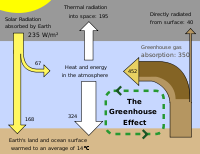California counting its carbon tax riches
May 29, 2012
By Katy Grimes
While the rest of the country shuns carbon trading schemes, California politicians continue to embrace the concept, and are forging ahead with a Cap and Trade carbon trading system. But eight states have dropped out of California’s Western Climate Initiative, leaving many scratching their heads in wonderment, as only California and Quebec are left alone to solve the world’s global warming and climate change issues.
But instead of being a real innovator and helping businesses sincerely lower emissions, California looks as if it is desperately clinging onto the notion that we can lead the rest of the world in controlling climate change, and behaving as a Nation State.
Why Quebec?
Cap and Trade was first concocted by the United Nations as a way to financially benefit from selling carbon offset credits. Vice-President Al Gore was already part of the Intergovernmental Panel on Climate Change, which helped seal the deal in the 1990’s through the Clinton administration’s involvement in the Kyoto Protocol, which mandated that nations reduce or offset carbon emissions.
This scheme must have been irresistible to the California Legislature, which passed AB 32, California’s Global Warming Solutions Act, in 2006. The original plan was to create a giant climate change coalition with other states and provinces from which carbon trading and taxing would emanate. But one by one, states have dropped out, citing the difficult economy and cost to manage such a program.
But not California.
“Linking with Québec is a significant advance in California’s efforts to fight climate change and steer our economy toward a clean energy future,” said CARB Chairman Mary D. Nichols. “Linking provides more options to California businesses and lays the groundwork for other partners to join with us. This sends a strong message to two national governments that now is the time to support innovation, energy efficiency and the development of clean technologies.”
But Quebec is not even a trading partner with California.
Counting the chickens before they are hatched
As part of his 2012-13 state budget, Gov. Jerry Brown made a gigantic assumption that the state will see $1 billion in cap-and-trade revenue. The state Legislative Analyst’s Office warned that this is a dangerous budget gimmick and an unstable calculation.
The California Air Resources Board passed cap-and-trade regulations in 2011 as part of its effort to implement AB 32. The air resources agency was granted authority by AB 32 to develop “market mechanisms” to reduce emissions to 1990 levels by 2020.
To achieve this, CARB developed its Cap and Trade program, and named 300 industries as the polluters, which will be required to buy carbon credits from the state in order to continue doing business in California.
When more closely examined, Cap and Trade appears to be a wealth redistribution program, by imposing a carbon tax on mostly private businesses, as well as utilities. Economists have warned that it will send businesses in California packing for other states.
While CARB continues to insist that Cap and Trade programs have been a smashing success, programs in Europe and the Northeast have failed, resulting in business closures and downsizes, and fewer tax revenues. Spain nearly went bankrupt with its green energy programs, by killing more jobs than it created. Many warn that Cap and Trade has failed every time it has been implemented, especially in the European Union and Japan.
But CARB will have to rely on companies to honestly report their emissions, which undoubtedly will lead to gaming the system, and cheating.
At a recent Assembly hearing on Cap and Trade, Assemblyman Brian Jones tried to put CARB’s role into perspective. But his objections were met with steely resistance from Assembly Democrats. “It is my perception since I’ve been elected and serving here for 14 months that CARB is a rogue agency” Jones said. “I want to reaffirm and state emphatically that CARB’s authority derives from this Legislature. It doesn’t derive on its own.”
“Your commissioners are not elected by the public or the voters of this state. We are elected by the voters of this state,” Jones continued. “And this Legislature has given over to CARB some authority that I believe CARB has run away with, and I am only hopeful that my colleagues in this committee and the rest of this Legislature will also come to the same conclusion that I’ve come to and soon realize that the authority of CARB comes from this Legislature, and we will start to rein that in and protect the voters and the public interest in this state.”
Global warming and political influence
In February, China ordered its airlines to ignore the 2008 European Union law which imposed a carbon emission tax on all flights traveling to and from the EU.
Moving in opposite directions, China continues to build coal plants, while California continues to enforce strict regulations to limit traditional forms of energy production, and encourage solar, wind along with other environmentally friendly alternatives.
Recent political history helps us understand how Cap and Trade works, and the political influence derived from its programs.
The now-defunct Chicago Climate Exchange, was founded by Chicago Board of Trade chief economist Richard Sandor, former Goldman Sachs & Co. CEO Hank Paulson, and former Vice President Al Gore, and started trading in 2003. The CCX received start-up funding from the Joyce Foundation in 2000 and 2001, during which time then-Senator Barack Obama sat on the board of directors.
The CCX had more than 400 members, which included corporate giants, auto manufacturers, universities, large utilities, and even Amtrack.
The CCX was estimated to make $10 trillion a year, and explains why California politicians continue to pledge support for California’s carbon trading program. But the CCX was closed down because the voluntary participation of its members waned as other carbon registries entered the market. The Climate Action Reserve and American Carbon Registry continue to operate.
Cap and Trade revenue hearing
CARB’s Board of Directors held a hearing last week to discuss the anticipated revenues from upcoming Cap and Trade auctions, and how they planned to spend the windfall monies.
“We are looking for synergy and consensus,” CARB Chairwoman Mary Nichols said at the hearing. Nichols said that in the transportation sector, efforts to capture the synergies have been successful, “which will help to make our state more competitive.”
Nichols reported that CARB does not know how much money will come in from carbon trading auctions, but the CARB Board estimates “several billion dollars each year.”
CARB invited two panels to participate in the hearing, made up of mostly environmentalist stakeholders, with the exception of the California Manufacturers and Technology Association, the lone voice for business.
Assemblywoman Diane Harkey, R-Dana Point, expressed her concerns at the hearing about how the Cap and Trade program will work, and whether the program will actually result in lower greenhouse gas emissions, as mandated by AB 32. Harkey suggested that it may just be a scheme to allow vast sums of money to change hands, with investors eventually getting rich off of market speculation, and with no improvement in the reduction of emissions.
Harkey warned that CARB was entering the sophisticated financial world of derivative markets and hedge derivatives, where investors get involved in betting, trading and profiting on the value of carbon credit shares. She warned that such sophisticated financial dealings should be managed by specialists, and not a state agency tasked with a mission of cleaner air.
Ignoring all warnings
Two years ago, the Christian Science Monitor published a joint investigation with the New England Center for Investigative Reporting, which found that existing carbon trading schemes were just another way to make money. “Carbon offsets are nothing more than the environmental equivalent of financial derivatives: complex, unregulated, unchecked and – in many cases – not worth their price,” the investigation reported.
“They are buying into projects that are never completed, or paying for ones that would have been done anyhow,” the investigation found. “Their purchases are feeding middlemen and promoters seeking profits from green schemes that range from selling protection for existing trees to the promise of planting new ones that never thrive. In some cases, the offsets have consequences that their purchasers never foresaw, such as erecting windmills that force poor people off their farms.”
Instead of heeding the many warnings, California is moving ahead at rapid speed to implement the first Cap and Trade auction in November.
As with most schemes, the catch is in the amount of empathy and guilt the con artist can elicit. Buying carbon offsets may ease eco-guilt, but experts have concluded that it will do absolutely nothing to lower the world’s carbon emissions, particularly as California goes it alone.
Related Articles
Down with Bully Bureaucrats!
You gotta love a website that puts a Drudge Report-like flashing police strobe light on their homepage. Lieutenant Governor candidate/state
State's Prisons Exploding
NOV. 5, 2010 By ANTHONY PIGNATARO It was apparently a matter of “disrespect.” It happened at Calipatria State Prison, located
Enviros battle over merits of rooftop solar vs. desert solar
Things aren’t working out well for renewable energy advocates who hoped cheaper rooftop solar energy would replace large solar power




